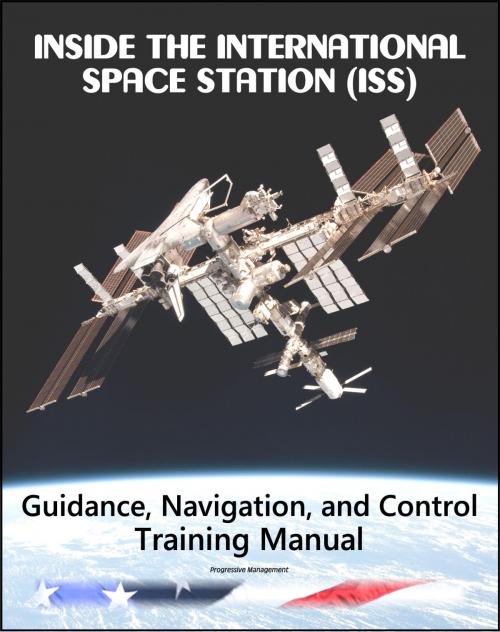Inside the International Space Station (ISS): NASA Guidance, Navigation, and Control (GNC) Astronaut Training Manual
Nonfiction, Science & Nature, Science, Physics, Astronomy| Author: | Progressive Management | ISBN: | 9781466156913 |
| Publisher: | Progressive Management | Publication: | December 17, 2011 |
| Imprint: | Smashwords Edition | Language: | English |
| Author: | Progressive Management |
| ISBN: | 9781466156913 |
| Publisher: | Progressive Management |
| Publication: | December 17, 2011 |
| Imprint: | Smashwords Edition |
| Language: | English |
Learn about the International Space Station (ISS) from the textbooks used by the astronauts! These astronaut and flight controller training manuals, produced by the Mission Operations Directorate (Space Flight Training Division branch) at NASA's Johnson Space Center, represent a major part of the formal flight crew training process. The manuals and workbooks are extremely detailed and comprehensive, and are designed for self-study. A full listing of all acronyms and abbreviations used in the text is included. They provide a superb way to learn about Station systems, hardware, and operational procedures. Special emphasis on crew interaction with the displays, controls, and hardware is included.
This training manual covers the ISS guidance, navigation, and control (GNC) system. Contents include:
U.S. Guidance, Navigation, and Control Overview * GNC Subsystem Software * Navigation * U.S. Attitude Control Subsystem * Motion Control System (MCS) Operations * GNC Computer System Details * Global Positioning System * ACS Performance Capabilities * GNC OPS
Guidance is used to tell the Station which route to follow from point A to point B. For the Station, this is generally executed as a point and fire reboost. The U.S. GNC Subsystem provides some guidance planning support; however, guidance is generally a Russian function.
Navigation is composed of the functions state determination, attitude determination, and Pointing and Support (P&S). This definition is different from that used on Shuttle, where navigation and state determination terms are used interchangeably. State determination answers the question, "Where am I?", attitude determination answers the question, "How am I oriented?", and Pointing and Support answers the question, "Where is everything else?"
The U.S. GNC Navigation Subsystem consists of software components residing in U.S. GNC Multiplexer/Demultiplexers (MDMs) and a set of GNC Orbital Replacement Units (ORUs). The U.S. GNC Navigation Subsystem maintains the onboard estimate of the position, velocity, attitude, and attitude rate of the ISS after Flight 8A.
State determination provides the ISS state vector (position and velocity at a specific time). The Global Positioning System (GPS) enables the Station to determine its position and velocity without ground uplinked data. The GNC flight software maintains precision estimates of position and velocity through propagation algorithms. These propagators accept periodic updates of the state vector data. Data is nominally provided by GPS but may also be provided by RS or ground-based updates. The RS GNC exchanges data with the U.S. GNC MDMs for redundancy and comparison tests.
The U.S. GNC Subsystem uses a GPS interferometry technique to determine the attitude of the Station. The GPS provides attitude updates to the U.S. GNC software once every 10 seconds, when at least four GPS satellites are in view. Two Rate Gyro Assemblies (RGAs) provide attitude rate information to propagate the attitude between GPS updates.
Learn about the International Space Station (ISS) from the textbooks used by the astronauts! These astronaut and flight controller training manuals, produced by the Mission Operations Directorate (Space Flight Training Division branch) at NASA's Johnson Space Center, represent a major part of the formal flight crew training process. The manuals and workbooks are extremely detailed and comprehensive, and are designed for self-study. A full listing of all acronyms and abbreviations used in the text is included. They provide a superb way to learn about Station systems, hardware, and operational procedures. Special emphasis on crew interaction with the displays, controls, and hardware is included.
This training manual covers the ISS guidance, navigation, and control (GNC) system. Contents include:
U.S. Guidance, Navigation, and Control Overview * GNC Subsystem Software * Navigation * U.S. Attitude Control Subsystem * Motion Control System (MCS) Operations * GNC Computer System Details * Global Positioning System * ACS Performance Capabilities * GNC OPS
Guidance is used to tell the Station which route to follow from point A to point B. For the Station, this is generally executed as a point and fire reboost. The U.S. GNC Subsystem provides some guidance planning support; however, guidance is generally a Russian function.
Navigation is composed of the functions state determination, attitude determination, and Pointing and Support (P&S). This definition is different from that used on Shuttle, where navigation and state determination terms are used interchangeably. State determination answers the question, "Where am I?", attitude determination answers the question, "How am I oriented?", and Pointing and Support answers the question, "Where is everything else?"
The U.S. GNC Navigation Subsystem consists of software components residing in U.S. GNC Multiplexer/Demultiplexers (MDMs) and a set of GNC Orbital Replacement Units (ORUs). The U.S. GNC Navigation Subsystem maintains the onboard estimate of the position, velocity, attitude, and attitude rate of the ISS after Flight 8A.
State determination provides the ISS state vector (position and velocity at a specific time). The Global Positioning System (GPS) enables the Station to determine its position and velocity without ground uplinked data. The GNC flight software maintains precision estimates of position and velocity through propagation algorithms. These propagators accept periodic updates of the state vector data. Data is nominally provided by GPS but may also be provided by RS or ground-based updates. The RS GNC exchanges data with the U.S. GNC MDMs for redundancy and comparison tests.
The U.S. GNC Subsystem uses a GPS interferometry technique to determine the attitude of the Station. The GPS provides attitude updates to the U.S. GNC software once every 10 seconds, when at least four GPS satellites are in view. Two Rate Gyro Assemblies (RGAs) provide attitude rate information to propagate the attitude between GPS updates.















